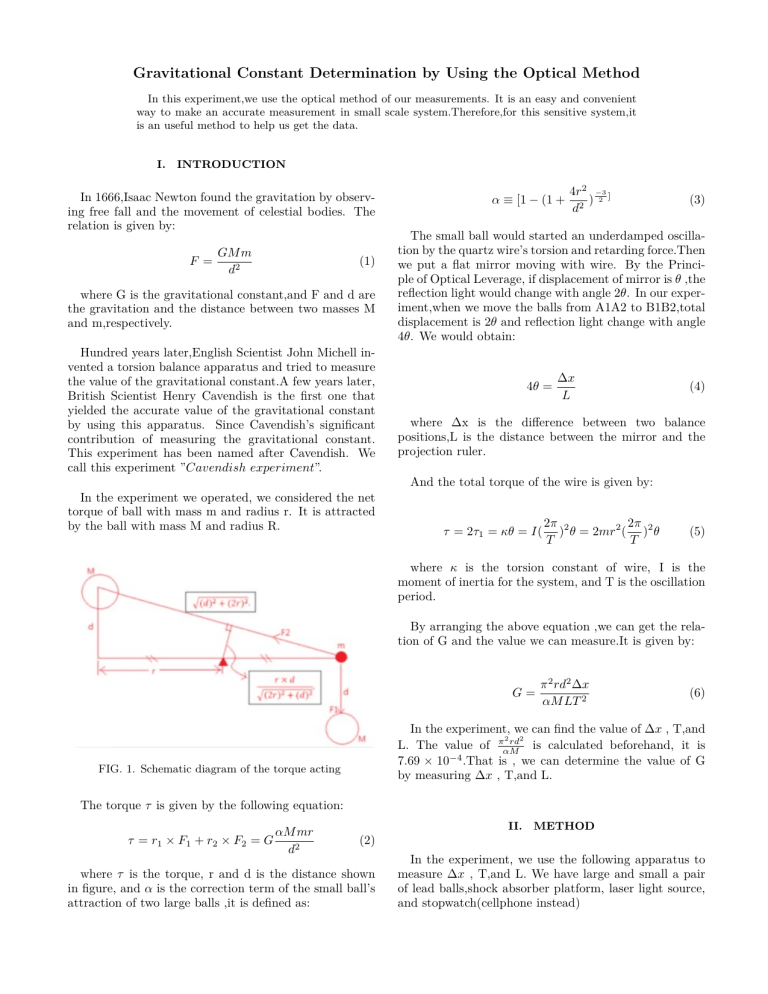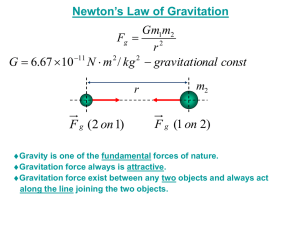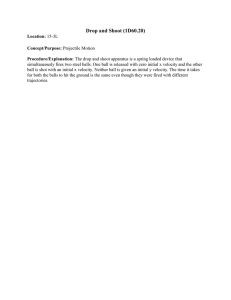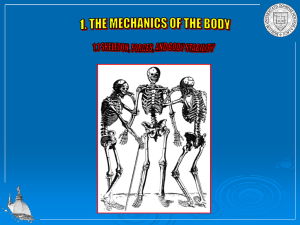
Gravitational Constant Determination by Using the Optical Method In this experiment,we use the optical method of our measurements. It is an easy and convenient way to make an accurate measurement in small scale system.Therefore,for this sensitive system,it is an useful method to help us get the data. I. INTRODUCTION In 1666,Isaac Newton found the gravitation by observing free fall and the movement of celestial bodies. The relation is given by: F = GM m d2 (1) where G is the gravitational constant,and F and d are the gravitation and the distance between two masses M and m,respectively. Hundred years later,English Scientist John Michell invented a torsion balance apparatus and tried to measure the value of the gravitational constant.A few years later, British Scientist Henry Cavendish is the first one that yielded the accurate value of the gravitational constant by using this apparatus. Since Cavendish’s significant contribution of measuring the gravitational constant. This experiment has been named after Cavendish. We call this experiment ”Cavendish experiment”. α ≡ [1 − (1 + 4r2 −3 ] )2 d2 (3) The small ball would started an underdamped oscillation by the quartz wire’s torsion and retarding force.Then we put a flat mirror moving with wire. By the Principle of Optical Leverage, if displacement of mirror is θ ,the reflection light would change with angle 2θ. In our experiment,when we move the balls from A1A2 to B1B2,total displacement is 2θ and reflection light change with angle 4θ. We would obtain: 4θ = ∆x L (4) where ∆x is the difference between two balance positions,L is the distance between the mirror and the projection ruler. And the total torque of the wire is given by: In the experiment we operated, we considered the net torque of ball with mass m and radius r. It is attracted by the ball with mass M and radius R. τ = 2τ1 = κθ = I( 2π 2 2π ) θ = 2mr2 ( )2 θ T T (5) where κ is the torsion constant of wire, I is the moment of inertia for the system, and T is the oscillation period. By arranging the above equation ,we can get the relation of G and the value we can measure.It is given by: G= π 2 rd2 ∆x αM LT 2 (6) In the experiment, we can find the value of ∆x , T,and 2 rd2 L. The value of παM is calculated beforehand, it is 7.69 × 10−4 .That is , we can determine the value of G by measuring ∆x , T,and L. FIG. 1. Schematic diagram of the torque acting The torque τ is given by the following equation: τ = r1 × F1 + r2 × F2 = G αM mr d2 II. METHOD (2) where τ is the torque, r and d is the distance shown in figure, and α is the correction term of the small ball’s attraction of two large balls ,it is defined as: In the experiment, we use the following apparatus to measure ∆x , T,and L. We have large and small a pair of lead balls,shock absorber platform, laser light source, and stopwatch(cellphone instead) 2 with the world standard value. III. RESULT Here we use MaTLAB to fit the curve,we did it twice,by using different distance.And we are going to show our result and compare with the world standard value. We use the following form to fit the curve: x = Ae−Bt sin( 2πt + D) + E C (7) The result of first time: FIG. 2. Schematic diagram of apparatus The mass and radius of large balls are 1.5 kg and 0.032m ,the mass of small balls are 0.015 kg and 0.0069m . r=0.05m, d=0.0465m. (a) A=11.4,B=0.0564,c=9.934,D=1.563,E=53.1 FIG. 3. The position of balls (From top to bottom) The only procedure we have to do is to measure the period of oscillation(T), difference of two balance point(∆x) and the distance from apparatus to ruler(L). First,put two large lead balls on A1 and A2 respectively.Wait for a few minutes to reduce the effect of external force. Then start to record the position of light spot per 30 seconds for about 3 periods. After finishing recording,put two large lead balls on B1 and B2 respectively and do the same way again. Don’t forget to measure the distance between apparatus to ruler to get the value of L. Finally , using MATLAB to plot the position against time and make fitline. We can get the information of ∆x and T. By using equation(6), we can calculate the value of G. We will operate twice to calculate the average and standard deviation of G. We will also compare G we derive (b) A=-9.695,B=-0.05364,c=9.993,D=-5.384,E=67 FIG. 4. The position-time plot From the data, T=9.964 min , ∆x=13.9 cm ,and L=294.5cm. We get G= 1.016×10−10 N − m2 /kg 2 The result of second time: 3 IV. DISCUSSION AND CONCLUSION A. (a) A=-22.37,B=-0.05931,c=9.59,D=45.3,E=59.54 (b) A=6.628,B=-0.05676,c=9.651,D=-0.5909,E=67.37 FIG. 5. The position-time plot From the data, T=9.621 min , ∆x=7.83 cm ,and L=196.5cm. We get G= 9.197×10−11 N − m2 /kg 2 Result and comparison: Table.1 Comparison of world’s standard value Average of G 9.679×10−11 (N − m2 /kg 2 ) Standard Derviation of G 6.809×10−12 (N − m2 /kg 2 ) World standard value of G 6.674×10−11 (N − m2 /kg 2 ) Discussion In this experiment, we reproduced the Cavendish experiment by using optical method. However, we get the larger value than we expected. The first reason of the result might be the small value of the gravitational constant. Any small perturbation may cause huge effect. The other reason is time scale, since small perturbation would have large influence. It would took a lot of time to become balance. We took about 3 periods of oscillation at first case while we took about 4 periods of oscillation at second case.The result shows that if we take for a long time, we may get the more accurate value the gravitational constant. This paragraph are going to discuss the precision of the experiment. We recorded the data by keeping watching the ruler . But we also have to check the stopwatch every 30 seconds for about 30 minutes to an hour. It would some error while recording. We can take a film instead and recording by replaying again. It may get the higher precision of the experiment. There are still one factor we want to discuss. It is about us. The experiment operator’s mass would have influence on our result or not. Suppose that there are a 90kg person,by gravitation law(Eq1). G,m is given, we only have to compare the value of M/d2 . Table.2 Different distance comparison Large ball’s value:673.18 Distance(m) The value of M/d2 0.2 2250 0.5 360 1 90 1.5 40 2 22.5 Though we are not a point of mass,we would not generate such a strong force.However, this table shows that if we are too close to the apparatus,it would cause nonnegligible effect.Therefore,when recording the data,we had better keep away from our apparatus to minimize the error. B. Conclusion Cavendish experiment use such a clever way to measure the gravitational constant. Since its convenience to operate and calculate. It is still a universal way to for scientist to measure the gravitational constant.Though we did the experiment roughly, the experiment inspired us to design others experiments to measure small constant or value.




